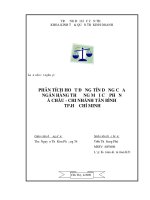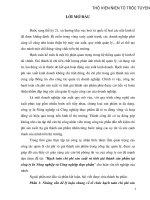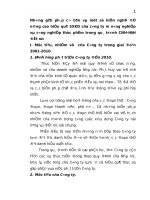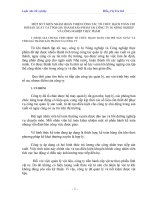Leaf reddening enigma in Bt cotton: A review - Trường Đại học Công nghiệp Thực phẩm Tp. Hồ Chí Minh
Bạn đang xem bản rút gọn của tài liệu. Xem và tải ngay bản đầy đủ của tài liệu tại đây (152.76 KB, 7 trang )
<span class='text_page_counter'>(1)</span><div class='page_container' data-page=1>
<i><b>Int.J.Curr.Microbiol.App.Sci </b></i><b>(2017)</b><i><b> 6</b></i><b>(11): 3764-3772 </b>
3764
<b>Review Article </b>
<b>Leaf Reddening Enigma in Bt Cotton: A Review </b>
<b>Vinayak Hosamani1*, B.M. Chittapur1, Venkatesh Hosamani2 and Rajanand Hiremath3</b>
1
University of Agricultural Sciences, Raichur, Karnataka, India
2
College of Horticulture, Munirabad-Koppal, Karnataka, India
3
College of Horticulture, Kerala Agriculture University, Thrissur, Kerala, India
<i>*Corresponding author </i>
<i><b> </b></i> <i><b> A B S T R A C T </b></i>
<i><b> </b></i>
<b>Introduction </b>
Cotton (<i>Gossypium </i>spp.), ‘the king of fibers’
also popularly known as ‘the white gold’
enjoys a pre-eminent position amongst cash
crops in the world and in India as well. It is
the nature’s most precious gift to the
mankind, contributed by the genus <i>Gossypium</i>
to clothe the people all over the world. There
is great discontent in different quarters with
the cultivars as some varieties are becoming
vulnerable to boll worm (mostly due to
spurious seed/F2 seed) and/or to many
physiological disorders and, hence, yield
below par (Venkateshwaralu, 2002) besides
producing poor quality fibreas reported in
Maharashtra and Gujarat (Hebbar and Mayee,
2011). Leaf reddening malady is the major
handicap in achieving potential crop yields,
particularly in <i>hirsutums</i> in majority of the
locations in spite of following best production
practices. Leaf reddening could reduce the
seed cotton yield to the extent of 30-60 per
cent depending on variety and reddening
intensity (Pagare, 2011) and time of
occurrence. The red colour becomes apparent
when the green chlorophyll decomposes with
the approaching winter (Anon., 2007) and,
therefore, early planting or use of cultivars
suitable for late planting to escape hardships
of winter assumes significance. Intense light
and low temperatures of winter favour the
development of anthocyanin pigments. The
principle cause of reddening is nitrogen and
magnesium deficiencies triggered by lower
nutrient availability and /or crop uptake
<i>International Journal of Current Microbiology and Applied Sciences </i>
<i><b>ISSN: 2319-7706</b></i><b> Volume 6 Number 11 (2017) pp. 3764-3772 </b>
Journal homepage:
The maximum yield potential of <i>Bt</i> cotton is yet to be trapped under irrigated
conditions which is low for various reasons. Among the different constraints in
cotton major reduction in yield is due to leaf reddening which results in 30-60% of
yield loss. Leaf reddening in cotton is also known as red leaf disease (<i>lal patti</i>).
This disorder is an outcome of interaction of location, variety, environmental
condition and nitrogen, potassium, magnesium etc. supply. In general, some of the
<i>hirsutum</i> varieties and a few inter and intra specific tetraploid hybrids are sensitive
and vulnerable to this malady. Appearance of red leaf symptom is primarily, due
to the accumulation of anthocyanin pigment. Identification of suitable reasons and
management of leaf reddening to increase the productivity in cotton is the key for
crop potential and hence, the review.
<b>K e y w o r d s </b>
Bt cultivars, Time of
sowing, Transplanting,
Nutrition, Target yield
approach.
<i><b>Accepted: </b></i>
26 September 2017
<i><b>Available Online:</b></i>
10 November 2017
</div>
<span class='text_page_counter'>(2)</span><div class='page_container' data-page=2>
<i><b>Int.J.Curr.Microbiol.App.Sci </b></i><b>(2017)</b><i><b> 6</b></i><b>(11): 3764-3772 </b>
3765
determined by inclement climate and/or poor
soil. Supply of nitrogen along with
phosphorus and potassium or potassium
nitrate and/or magnesium to the leaf at these
stages to reduce the formation of anthocyanin
and achieve potential yields is critical
(Sathyanarayanrao, <i>et al.,</i> 2014, Honnali and
Chittapur, 2017 and Basavenneppa <i>et al.,</i>
2015). This brings-forth the importance of
plant nutrition in the management of leaf
reddening for achievable harvests hence, this
attempt.
<b>Causes of reddening</b>
In India several studies have been carried out
on the field to identify the reasons for leaf
reddening malady (Table 1). Leaf reddening
appears to be a physiological disorder
associated with several factors <i>viz.,</i>
environment, nutrient, soil type, genotype and
physiological parameters. Dastur and Bhatt
(1956) observed that there was an
accumulation of carbohydrates in the leaves
when cotton plant had nearly reached the
stage of senescence. Das and Leopold (1964)
reported that the photosynthetic rate was
reduced at senescence. Moore and Lovell
(1936) found that in senescent leaves, the leaf
chlorophyll content was approximately
linearly related to the estimated area of yellow
tissue. Interestingly, Burt and Haider (1919)
reported this phenomenon in Cawnpore
American cotton in United Provinces. They
suggested that the red leaf disease was due to
an attack of aphids. Kottur (1920) suggested
that the jassid might be the vector in carrying
the red leaf disease and claimed success in
warding off the disease by dusting with
sulphur. Evans (1926) reported that the
phosphate and potash deficiency in soil and
hopper and jassids caused the red leaf disease
in cotton at New Guinea. Simultaneously,
Sawhney (1932) observed that the red leaf
blight of <i>Buri </i> cotton has been known in
Hyderabad. The red pigment in leaves was
reported to be developed as a result of injury
caused by jassid. Ramiah and Nath (1945)
found that the red colour in <i>Gossypium </i>
<i>hirsutum </i>leaves occurred uniformly over the
whole upper surface. They suggested that
itmay also occur in patches on both surfaces
due to an attack of jassids.
</div>
<span class='text_page_counter'>(3)</span><div class='page_container' data-page=3>
<i><b>Int.J.Curr.Microbiol.App.Sci </b></i><b>(2017)</b><i><b> 6</b></i><b>(11): 3764-3772 </b>
3766
December is also responsible for red leaf in
cotton.
At Dharwad, Karnataka Prabhakar (1981)
observed that leaf reddening was not noticed
in October and it was started in November
and increased in December and January.
Chimmad (1989) also from Dharwad reported
that all the genotypes revealed an increasing
trend for red leaf index from II fortnight of
October (boll development stage) to maturity.
Correlations indicated that anthocyanin
accumulation was significantly negative with
N, P, K, Ca and Mg contents of leaf. The
chlorophyll content decreased and
anthocyanin content increased as the crop
attained maturity. This malady has been found
to cause serious losses in the high yielding
cultivars of <i>Hirsutum </i> and <i>Barbadenses. </i>
Further, Chimmad and Panchal (1998) opined
that the lower leaf nitrogen (<2.5%) content,
higher accumulation of anthocyanin content,
lower temperature (100C) and higher per cent
of solar radiation were associated with leaf
reddening. Bhatt <i>et al.,</i> (1982) also found
reddening of cotton leaves is primarily
associated with low leaf N concentrations and
reduced amino acid levels of prematurely
reddened cotton leaves. Simultaneously,
Shanmugham (1992) reported that drop in
temperature below 21°C stimulates the
formation of anthocyanin pigment particularly
the sudden fall in night temperature below
15°C stimulates the formation of anthocyanin
pigment. The reddened leaves reveal low
chlorophyll content with high anthocyanin
pigment. This malady has been found to cause
serious losses in the high yielding cultivars of
<i>hirsutum </i> and <i>barbadenses. </i> The critical N
requirement of leaf is 2.0-2.6% if it falls
below this reddening of leaf triggered.
Further, Wright (1999) found that cotton
plants with severe reddening symptoms had
55 - 66%, heavier total boll mass and their
leaves had only about half the potassium (K)
and three quarters the phosphorus (P)
concentration of unaffected plants. Hence,
affected plants had less leaf K and P to meet
the demand of a heavy boll load. Velikova <i>et </i>
<i>al.,</i> (2002) observed the damage of
photosynthetic activity upon reddening may
be caused by oxidative stress due to K
shortage and corresponding accumulation of
Na ions. The oxidative stress in cotton may be
partly counteracted by the strong
accumulation of anthocyanins having
protective antioxidants and antiradical
functions.Hebbar <i>et al.,</i> (2007) reported that
synchronized boll development in <i>Bt</i> plants
altered the source–sink relationship due to
rapid translocation of saccharides and
nutrients from leaves to the developing bolls.
Kaur <i>et al., </i>(2007) also made similar findings.
Adoption of modern cotton varieties is
another important factor for K deficiency,
since sensitivity of cotton to potassium varies
with genotypes. Many reports have indicated
that modern cotton varieties with fast fruiting,
high yielding or heavy boll load and early
maturity seem to be more susceptible to K
limitation than traditional varieties. Pagare
and Durge (2011a) reported that reduction in
the chlorophyll content and accumulation of
more anthocyanin content in leaf is
responsible for reddening in cotton.
Anthocyanin content increased in reddening
affected leaves in the range of 4.94 to 5.06 per
cent at square formation stage compared to
normal leaf. While, Naidu and Mahalakshmi
(2011) reported that reduction in the
photosynthetic rate, stomatal conductance and
transpiration were responsible for reddening
of cotton leaves. There was reduction in
contents of N, P, K, Ca, Mg, Zn and Mn in
reddening leaf with the increase of Na, Fe and
Cu.
<b>Varietal response to leaf reddening </b>
</div>
<span class='text_page_counter'>(4)</span><div class='page_container' data-page=4>
<i><b>Int.J.Curr.Microbiol.App.Sci </b></i><b>(2017)</b><i><b> 6</b></i><b>(11): 3764-3772 </b>
3767
in <i>Hirsutum </i>and <i>Barbadens </i>than in <i>Desi </i>types
(Alston, 1959). However, not much further
work followed to screen cultivars to leaf
reddening or its impact on cultivar
performance.
In Karnataka, Chimmad and Panchal (1998)
reported that genotypes MCU-5, DCH-32 and
lakshmi recorded higher levels of red leaf
index, anthocyanin content in leaf at all
growth stages and lower seed cotton yield
while, RAMPBS-218 and RAMPBS -296
remained green with lower red leaf index,
anthocyanin content in leaf and recorded
higher seed cotton yield. At Akola, Pagare
(2011b) revealed that reddening of leaves was
more pronounced in <i>Gossypium hirsutum</i>
resulting in lower seed cotton yield. Among
the tested genotypes MRC- 6301 was more
prone to reddening of leaf compared to
NSC-145 and TCHH-4. Further, Pagare and Durge
(2011a) reported that, healthy cotton leaves
has maximum chlorophyll content compared
to reddened leaves. The reduction of
chlorophyll content in red leaf was more in
MRC-6301 <i>Bt</i> cotton hybrid. Anthocynin
content in red leaves was maximum in all the
<i>Bt </i>cotton varieties compared to healthy leaves
of <i>Bt</i> cotton varieties at all the growth stages.
Interestingly, Hosmath <i>et al.,</i> (2012) at
Dharwad, Karnataka reported that, Neeraja
(BG II) <i>Bt </i> registered significantly higher
SPAD value (40.91, 42.98 at 90 and 120
DAS, respectively). chlorophyll ‘a’ content
(0.87, 1.02 mg g-1 fresh weight at 90 and 120
DAS, respectively), chlorophyll ‘b’ content
(0.51, 0.54 mg g-1 fresh weight at 90 and 120
DAS, respectively) and total chlorophyll
content (1.29, 1.61 mg g-1 fresh weight at 90
and 120 DAS, respectively) compared to
other <i>Bt</i> cotton genotypes. Neeraja (BG Il) <i>Bt</i>
also recorded significantly lower
accumulation of anthocyanin content (0.092,
0.187 mg g-1 fresh weight at 90 and 120 DAS,
respectively) and red leaf index (0.65, 2.0
during 90 and 120 DAS, respectively)
compared to other <i>Bt</i> cotton hybrids. While
from same place Sudha (2011) recorded
significantly higher SPAD value (43.10,
44.35 and 42.70 at 90, 120 DAS and at
harvesting, respectively) in MRC-6918 <i>Bt</i>
compared to other <i>Bt</i> cotton hybrids and
lowest SPAD value was registered in RCH-2
<i>Bt</i> (39.30, 38.15 and 37.40 at 90, 120 DAS
and at harvest, respectively).
<b>Amelioration of leaf reddening </b>
Several studies have been carried out on the
field to identify the reasons for leaf reddening
malady. Nageshwara Rao (1976) reported
18-23% increase in yield with 50 to 60%
recovery from reddening to greenness by an
application of 0.5% MgSO4 spray. There was
significant increase in seed cotton yield with
foliar application of 2% magnesium and 0.2%
zinc and also with combination of zinc and
magnesium (Eweida <i>et al.,</i> 1979). At
Dharwad, Prabhakar (1981) found that foliar
application of 2% urea + 1% single super
phosphate four times at 15 days interval
during November and December helped to
control the leaf reddening. Koraddi <i>et al., </i>
(1991) studied the effect of nutrients and
growth regulators on leaf reddening in cotton.
They observed no influence of magnesium in
checking leaf reddening. They found that
foliar application of 20-10-10 kg NPK ha-1 in
four equal instalments was effective in
checking the leaf reddening with highest seed
cotton yield (2465 kg ha-1). Chaudhari <i>et al., </i>
(2001) reported that spraying of 2% DAP and
2% urea at 45 and 75 DAS respectively
increased bolls plant-1 (12.70 and 12.41), yield
plant-1 (24.48 and 24.30 g) and yield ha-1
(10.79 and 10.64 q) and reduced the leaf
reddening in cotton over control.
</div>
<span class='text_page_counter'>(5)</span><div class='page_container' data-page=5>
<i><b>Int.J.Curr.Microbiol.App.Sci </b></i><b>(2017)</b><i><b> 6</b></i><b>(11): 3764-3772 </b>
3768
Further, they opined that application of KNO3
containing both potassium and nitrate, applied
at critical growth period helped in the
retention and development of the bolls on the
plant which significantly contributed to
increase of seed cotton yield. Similarly, Singh
(2004) observed that foliar application of urea
(2-4%) with 15-20 ppm chlormequate
chloride) and 0.1% citric acid, 2-3 times at
weekly intervals resulted in 70-80%
amelioration. While, application of MgSO4 at
20-25 kg ha-1 to soil or as foliar spray with
5% MgSO4 and 1% urea as soon as the
reddening symptoms appear in leaf reduces
this disorder (Ikisan, 2004).
<b>Table.1 </b>Reason for leaf reddening in cotton
<b>Reasons </b> <b>References </b>
Accumulation of carbohydrates,
stomata conductance and
senescence of leaves
Dastur and Bhatt (1956), Das and Leopold (1964), Moore
and Lovell (1936)
Sucking pest Burt and Haider (1919), Kottur (1920), Sawhney (1932) and
Nutrient deficiency Dabral (1938), Dastur and Ahad (1941), Serry and Wad
(1958), Dastur and Singh (1947), Wright (1999), Bhatt <i>et al.,</i>
(1982), Wright (1999), Velikova <i>et al.,</i> (2002),). Hebbar <i>et </i>
<i>al.,</i> (2007) and Kaur <i>et al., </i>(2007)
Environment Dastur (1967), Prabhakar (1981), Chimmad and Panchal
(1998) and Shanmugham (1992)
Reduction in chlorophyll and
accumulation of anthocyanin
Pagare and Durge (2011)
In Karnataka, application of 2% urea or 2%
DAP or 1% MgSO4 at 90 and 110 DAS for
control of leaf reddening has been
recommended from the University of
Agricultural Sciences, Dharwad (Anon.,
2005). Subsequently, at Dharwad, while
studying effect of foliar feeding of nutrients
on <i>Bt</i> cotton it was found that foliar
application of MgSO4 (1.0%) at flowering and
boll development stage + DAP (2%) at boll
development stage significantly increased the
seed cotton yield (2399 kg ha-1) and reduced
the leaf reddening in cotton over control
treatment (2245 kg ha-1) (Anon., 2010).
Similarly in another study at Dharwad, it was
found that combined foliar sprays of KNO3
(2%) at 80 and 100 DAS + MgSO4 (1%) at
80, 100 and 120 DAS (3371 kg ha-1)
registered on par seed cotton yield with
MgSO4 (1%) spray (3235 kg ha-1) at 90 and
110 DAS besides less reddening incidence
</div>
<span class='text_page_counter'>(6)</span><div class='page_container' data-page=6>
<i><b>Int.J.Curr.Microbiol.App.Sci </b></i><b>(2017)</b><i><b> 6</b></i><b>(11): 3764-3772 </b>
3769
g-1) content and increased chlorophyll content
(4.37 mg g-1 fresh weight) compared to 50%
RDF (0.25 mg g-1 and 3.68 mg g-1 fresh
weight).
Perane <i>et al.,</i> (2011) revealed maximum of
46.53% reddening where the fertilizers were
not applied. The maximum reduction 49.83%
in leaf reddening and improvement in seed
cotton yield was observed with application of
10 t ha-1 FYM + 125% RDF (125:63:63 NPK
ha-1) + two sprays of micro nutrients. Ambati
and Soniya (2012) reported that application of
150% RDF along with soil application of
MgSO4 at 25 kg ha-1 in shallow soil
significantly reduced the formation of red
leaves in the month of October. Increased
splits of nitrogen also appears to be promising
as Gawade and Bhalero (2012) reported that
application of nitrogen at six splits recorded
significantly lower leaf reddening and
maximum seed cotton yield (34% and 6.86 q
ha-1) over other split application. Similarly,
Giri <i>et al.,</i> (2013) also revealed that
application of nitrogen at six split recorded
significantly lower leaf reddening at 90, 120
and 150 DAS and seed cotton yield (3015 kg
ha-1).
While studying the management of leaf
reddening in <i>Bt</i> cotton through nutrients under
irrigated condition, application of 125% RDF
based on soil test values recorded higher
values of plant height (116.6 cm), number of
sympodia (22.2 plant-1), number of bolls (27.4
plant-1), boll weight (4.8 g) and seed cotton
yield plant-1 (98.5 g) and seed cotton yield
(1718 kg ha-1) compared to RDF alone (111.9
cm, 20.9 plant-1, 25.0 plant-1 and 4.61 g, 98.0
g plant-1 and 1585 kg ha-1) (Anon., 2012b).
The number of reddened leaves with 125%
RDF at 90 and 120 DAS was 4.06 plant-1 and
5.20 plant-1 as against 4.73 and 5.53 plant-1
with RDF application. Santhosh <i>et al.,</i> (2015)
reported that leaf reddening index was
significantly reduced with higher NPK
fertilizers (150% RDF) and also with foliar
spray of MgSO4 + KNO3 thrice combined
with initial soil application of MgSO4 at 25 kg
ha-1. In UKP irrigation command, Shivaraja
(2015) obtained 4209 kg ha-1 seed cotton yield
with basal application of MgSO4 @ 25 kg ha-1
along with foliar spray of MgSO 4 + 19:19:19
@ 1% each for leaf reddening management
(LRM) which was significantly superior over
control with no LRM practices (3893 kg ha-1).
Further, the leaf reddening index (LRI)
recorded was significantly lower in former
treatment of LRM practices (0.69, 1.07 and
1.72 at 60, 90 and 120 DAS, respectively)
compared to control (0.78, 1.25 and 1.84 at
60, 90 and 120 DAS, respectively). In
Karnataka foliar spray of MgSO4 and
19:19:19 NPK is now recommended for
general practice (Sathyanarayanrao <i>et al.,</i>
2014 and Anon., 2016) for the management of
leaf reddening While, Honnali and Chittapur
(2017) reported that 25% extra RDF 150 (4
splits at monthly interval):75:75 kg ha N,
P2O5 and K2O along with soil application of
25 kg ha-1 MgSO4 at planting followed by
foliar spray thrice each of 1.0% MgSO4 and
19:19:19 NPK at 80, 105 and 130 days after
sowing coinciding with square formation,
peak flowering and boll development
recorded lower scores for leaf reddening
(0.67) and higher seed cotton yield (2.07 t
ha-1), sustainability yield index (90.59%) and
economics (` 73,630 and 2.65 net returns and
B:C ratio, respectively) in comparison to
application of recommended dose of fertilizer
(0.87,1.63tha-1,70.41%, Rs. 57,380 and 2.38,
respectively).
</div>
<span class='text_page_counter'>(7)</span><div class='page_container' data-page=7>
<i><b>Int.J.Curr.Microbiol.App.Sci </b></i><b>(2017)</b><i><b> 6</b></i><b>(11): 3764-3772 </b>
3770
lowering of night temperature, excessive boll
load, low soil nitrogen supply, abiotic stress
like water shortage or stagnation, biotic stress
due to jassids, synthesis and accumulation of
anthocynin pigments etc. resulting in
reddening of leaves, petiole, and then stem
starting from the lower canopy extending to
terminal portion with passage of time. At
grand growth phase (flowering and boll
development) any hindrance in the assimilate
production, translocation and distribution
intensifies the leaf reddening effect. Since,
leaf reddening is an irreversible process
occurring at later stages of crop growth in
response to growing conditions corrective
measures need to be initiated at appropriate
stages.
Reddening is a complex phenomenon and
there is no single reason why leaves turn red.
The survey data on constraints of Bt cotton
cultivation indicated that 93% of farmers
facing the problem of leaf reddening and
majority of the farmers not adapted the
control measures. Now a day’s majority of the
cotton growers in India as well as Karnataka
have expressed that bt cotton was very
susceptible to leaf reddening and also they
touching the doors of agriculture university
and extension agencies for the reason and
efficient control of leaf reddening hence there
is a need to intensified research work on
finding the exact reason and management of
leaf reddening and to give the crop condition
in parcel basis in necessary.
<b>References </b>
Alston Ralph, 1959, Physiology and the
inheritance of anthocyanin pattern.
<i>Genetica</i>, 30: 261-277.
Amboti Ravender Raju and Soniya (2012),
Effect of nutrient management on FUE,
red leaf, fibre properties of <i>Bt</i> cotton
(<i>Gossypium hirsutum</i> L.). I<i>ndian J. </i>
<i>Agronomy,</i> 57(4):390-396.
Anonymous, 2010, <i>Annual report of the </i>
<i>AICCIP</i>, Karnataka, pp. 20-34.
Anonymous, 2016, <i>Package of Practices</i>
(Kannada- <i>Sudharita </i> <i>Besaya </i>
<i>Kramagalu</i>), University of Agricultural
Sciences, Dharwad and University of
Agricultural Sciences, Raichur,
Karnataka, pp. 199-201.
Balls, W. L., 1908, Mendelian studies of
Egyptian cotton. <i>J. Agric. Sci</i>., 2:
346-379.
Baloch, M., S.H. Ghaloo and A.A. Rajper.
2001. Are cotton fiber characters under
influence of planting dates? <i>Life Sci.Int. </i>
<i>J</i>., 1(1): 1-5.
Basavanneppa, M. A., Ajaykumar, M. Y.,
Nidagundi, J. M. and Biradar, D. P.,
2015, Response of <i>Bt</i> cotton to foliar
application of potassium nitrate in
Tungha Bhadra project area. <i>J. Cotton </i>
<i>Res.h and Develop.,</i> 29 (2):242-245.
Brar, M. S. and Brar, A. S., 2001, Effect of
foliar application of nutrients on yield
of <i>hirsutum </i>cotton. In: <i>Proceedings of </i>
<i>National </i> <i>Symposium </i> <i>on </i> <i>Cotton </i>
<i>Research Strategies of New Millennium</i>,
16 April 2001, CCS Haryana Agri. Uni.,
Hisar, pp. 24.
Chaudhari, C. S., Pawar, W. S., Mendhe, S.
N., Nikam, R. R. and Ingole, A. S.,
2001, Effect of land configuration and
nutrient management on yield of rainfed
cotton. <i>J. Soils Crops</i>, 11(1): 125-127.
Chimmad, V. P. and Panchal, Y. C., 1998,
Leaf reddening in cotton genotypes I.
Anthocyanin. <i>Karnataka J. Agric. Sci</i>.,
11(4): 902-907.
Chimmad, V.P., 1989, Physiological and
biochemical investigations on leaf
reddening in cotton genotypes. <i>Ph.D. </i>
<i>Thesis, Uni. Agric. Sci., Dharwad,</i> pp.
1-420.
Dabral, B. M., 1938, 1st Con. Sci. Red Works
Cott. India, I.C.C.C., Bombay.
</div>
<!--links-->
Một số giải pháp chủ yếu nhằm nâng cao hiệu quả sản xuất kinh doanh của Công ty In Nông nghiệp và Công nghiệp Thực phẩm.doc
- 53
- 1
- 5








